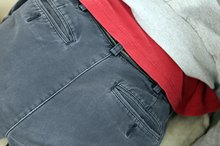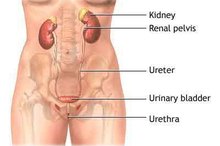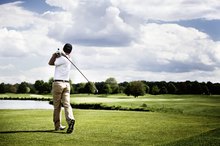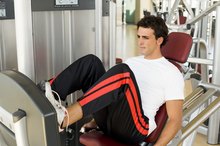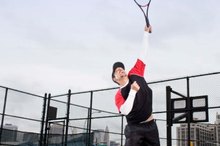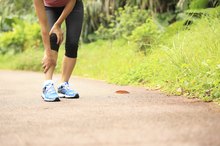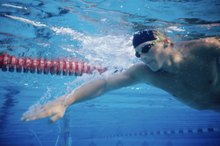Golf & Rhomboid Strain
While lower back injuries are common among golfers, the rhomboid muscle located in the upper back can also be injured during golf. The triangular-shaped rhomboid muscle lies between the shoulder blades and connects the inside edges of the blades to the spine. Golfers who strain the muscle may need to avoid playing until they've recovered, and should learn techniques to prevent the rhomboid from being re-injured when they return to the game.
Cause
Rhomboid strains typically occur in people who participate in activities or sports that require the arms to be repeatedly lifted above the head, such as tennis or baseball. However, a golfer may develop a rhomboid strain if she frequently carries a heavy golf bag over one shoulder for long periods of time or swings her golf club repeatedly with great force. A study on golf injuries published in "Physical Medicine and Rehabilitation Clinics of North America" in 2006 also reported that older golfers were at a greater risk of suffering a rhomboid strain from repeated golf swings.
Symptoms
What Are the Treatments for Muscle Strain of One Side of the Buttocks?
Learn More
A golfer with a strained rhomboid will feel a sharp, burning pain or tightness directly between his shoulder blades. The pain may increase when the shoulders are moved, or with deep breaths. The golfer may experience too much pain to move her arms freely, especially if the tissues in the strained muscle swell and press on a nerve within the spinal cord. The area between the shoulder blades may be tender to the touch.
- A golfer with a strained rhomboid will feel a sharp, burning pain or tightness directly between his shoulder blades.
- The golfer may experience too much pain to move her arms freely, especially if the tissues in the strained muscle swell and press on a nerve within the spinal cord.
Treatment
The initial treatment for a rhomboid strain is to decrease the inflammation in the muscle. Doctors recommend icing the area for two to three days after the injury for 20 to 30 minutes every three to four hours. If the pain persists, an anti-inflammatory drug may be used. After the pain is under control, the golfer should treat the strain with massage, gentle stretching and rehabilitation exercises designed to strengthen both the rhomboid muscle and the surrounding back and shoulder muscles. According to orthopedic surgeon Paul Scott Shapiro, it may take a golfer from two weeks to over six weeks to fully recover from a rhomboid strain. During this time, you shouldn't play golf or engage in any activity that increases your rhomboid pain.
- The initial treatment for a rhomboid strain is to decrease the inflammation in the muscle.
- After the pain is under control, the golfer should treat the strain with massage, gentle stretching and rehabilitation exercises designed to strengthen both the rhomboid muscle and the surrounding back and shoulder muscles.
Prevention
Groin Pain After Golf
Learn More
There are three ways you can prevent a golf-related rhomboid strain: warm up thoroughly before golfing, stop carrying your golf bag on only one shoulder and make strength-training exercises a part of your daily routine to build up your muscle strength. Prior to playing, reserve 20 minutes for a walk, some light stretches focusing primarily on your shoulders and back and some relaxed practice swings. Take another 20 minutes after playing to stretch again and cool down. Use a golf bag that has two straps to allow you to distribute the weight evenly on both shoulders, or invest in a wheeled golf cart.
- There are three ways you can prevent a golf-related rhomboid strain: warm up thoroughly before golfing, stop carrying your golf bag on only one shoulder and make strength-training exercises a part of your daily routine to build up your muscle strength.
- Prior to playing, reserve 20 minutes for a walk, some light stretches focusing primarily on your shoulders and back and some relaxed practice swings.
Related Articles
References
- Austin Regional Clinic: Rhomboid Strain or Spasm
- Spine-Health: Preventing Low Back Pain from Golf
- Canadian Chiropractic Association: Back Facts - Golf
- Yoo WG. Effects of pulling direction on upper trapezius and rhomboid muscle activity. J Phys Ther Sci. 2017;29(6):1043–1044. doi:10.1589/jpts.29.1043
- Kang JH, Park RY, Lee SJ, Kim JY, Yoon SR, Jung KI. The effect of the forward head posture on postural balance in long time computer based worker. Ann Rehabil Med. 2012;36(1):98–104. doi:10.5535/arm.2012.36.1.98
- Kendall FP, Kendall McCreary E, et. al. Muscles: Testing and Function with Posture and Pain. 5th ed. Williams and Wilkins. 2014.
Writer Bio
Michelle Kerns writes for a variety of print and online publications and specializes in literature and science topics. She has served as a book columnist since 2008 and is a member of the National Book Critics Circle. Kerns studied English literature and neurology at UC Davis.
